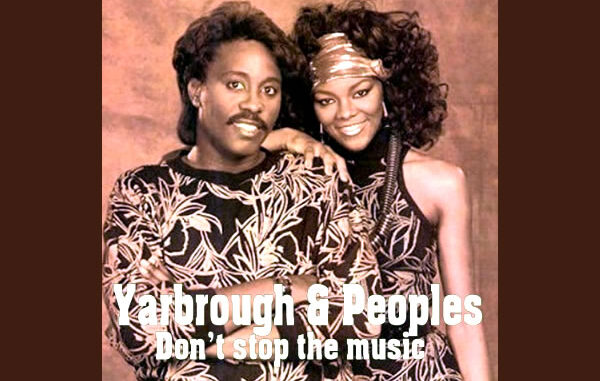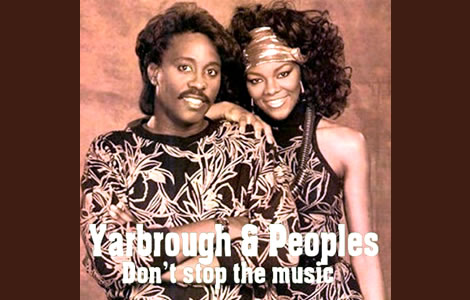
Yarbrough and Peoples’ 1980 hit “Don’t Stop the Music” stands as a quintessential example of early 80s R&B and funk, a genre that defined an era of dance music and soulful grooves.

This song, with its infectious rhythm and memorable hook, was not only a commercial success but also a significant cultural artefact that encapsulated the spirit of the time.
Background of Yarbrough and Peoples
Yarbrough and Peoples were a dynamic duo hailing from Dallas, Texas, consisting of Cavin Yarbrough and Alisa Peoples. Both members had a strong musical background; Yarbrough was a talented keyboardist and singer, while Peoples had been singing since childhood.
Their partnership began in the mid-1970s, but it wasn’t until they were discovered by Charlie Wilson of The Gap Band that their career truly took off. Wilson introduced them to Lonnie Simmons, the founder of Total Experience Records, who signed them to the label.
This connection would be pivotal, as Total Experience Records was home to several successful acts in the R&B and funk scene during the late 70s and early 80s.
The Appeal of “Don’t Stop the Music”
Released in December 1980, “Don’t Stop the Music” quickly became a dance floor anthem. The track’s appeal lay in its seamless blend of funk and R&B, characterised by a pulsating bassline, crisp percussion, and the distinctive keyboard riffs played by Yarbrough himself. Alisa Peoples’ vocals added a smooth yet powerful layer to the song, making it both soulful and energetic.
The lyrical content of “Don’t Stop the Music” was simple yet effective, urging listeners to keep the party going and lose themselves in the rhythm. This resonated deeply with audiences, especially at a time when dance music was a central aspect of social culture.
The song’s structure, with its repetitive hook and call-and-response elements, was designed to keep listeners engaged and on their feet.
This made it a favorite not only in nightclubs but also on radio stations that catered to the growing appetite for danceable R&B music.
The track’s production quality, courtesy of Lonnie Simmons, was also ahead of its time, with a clean, polished sound that stood out among other releases in the genre.
Chart Success
“Don’t Stop the Music” was a commercial success, particularly in the United States, where it reached No. 1 on the Billboard R&B chart in February 1981 and peaked at No. 19 on the Billboard Hot 100. This crossover appeal was a significant achievement, considering the competitive nature of the music industry at the time.
The song also found success internationally, charting in the UK, where it reached No. 7 on the UK Singles Chart. This made Yarbrough and Peoples one of the few R&B acts to break into the UK market during that period.
In Europe, “Don’t Stop the Music” enjoyed moderate success, particularly in countries like Germany and the Netherlands, where it became a staple in dance clubs.
In Australia, the song made its way onto the charts, reflecting the global reach of R&B music during the early 80s. In Asia, particularly in Japan, the song was well-received in the burgeoning disco scenes of cities like Tokyo, where Western music was increasingly popular.
Global and Cultural Context
The success of “Don’t Stop the Music” in 1980-1981 came at a time when the world was experiencing significant cultural and political shifts.
The early 80s marked the beginning of the Reagan era in the United States, a period characterised by conservative politics and economic change. In the UK, Margaret Thatcher was in power, and her policies were reshaping the British economy and society.
Despite the political conservatism of the time, the music scene remained vibrant and innovative, with genres like R&B, funk, and the emerging new wave and electronic music movements driving cultural trends.
In December 1980, the world was also shocked by the assassination of John Lennon, a moment that sent ripples through the global music community.
The event underscored the volatility of the time, but also highlighted the power of music as a unifying force. In this context, “Don’t Stop the Music” served as a reminder of the joy and release that music could provide, even in uncertain times.
Culturally, the early 80s were marked by a growing fascination with technology and the future, themes that would later dominate much of the decade’s music and fashion.
The rise of MTV in 1981 would further revolutionise the music industry, giving visual artists like Yarbrough and Peoples new platforms to reach audiences.
The duo’s sleek, stylish image and their ability to blend traditional R&B with more modern, electronic sounds positioned them well within this new cultural landscape.
Remembering the Moments on Capitol.fm
“Don’t Stop the Music” remains a classic in the R&B and funk genres, continuing to be played on old-school radio stations and at retro-themed parties.
Its influence can be seen in the work of later artists who sought to capture the same blend of rhythm and melody that made the song a hit. For Yarbrough and Peoples, “Don’t Stop the Music” was the pinnacle of their career, earning them a place in the pantheon of great R&B acts from the early 80s.
In conclusion, “Don’t Stop the Music” by Yarbrough and Peoples is more than just a song; it’s a snapshot of a moment in time when music had the power to bring people together and provide an escape from the challenges of the world.
Its success across multiple continents underscores its universal appeal, and its legacy continues to resonate with music lovers to this day.
